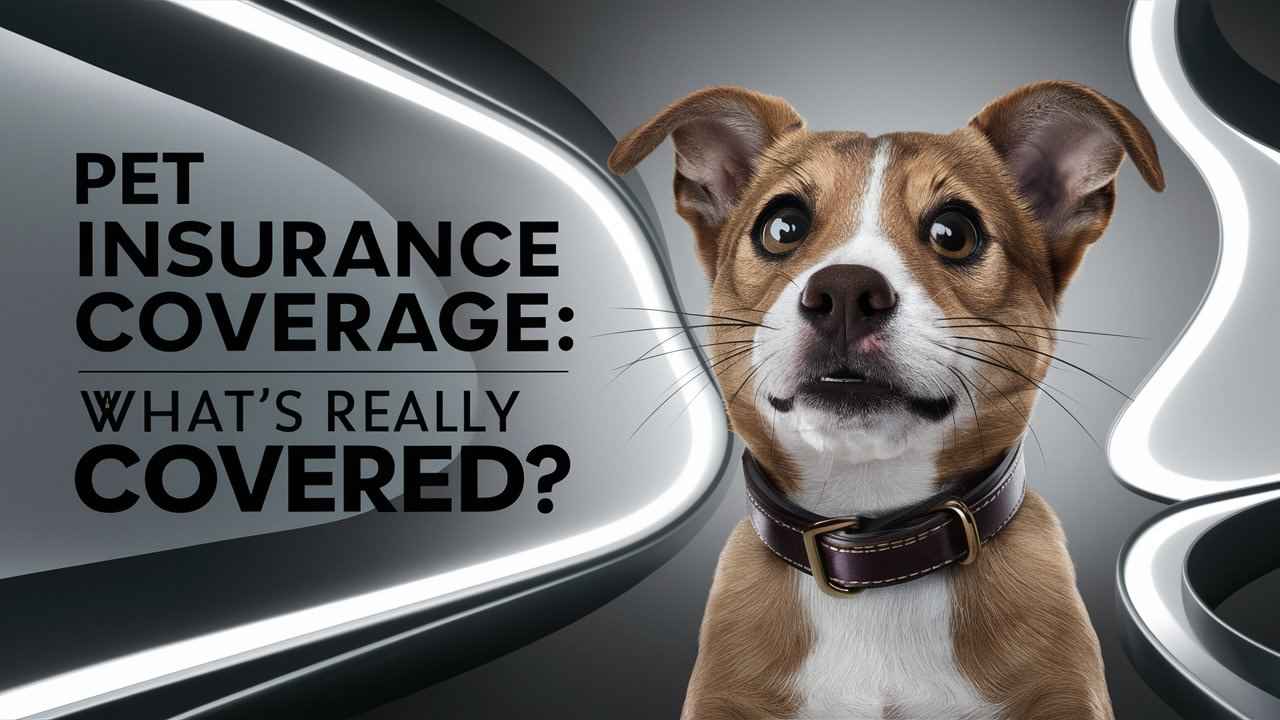What Pet Insurance Covers (and What It Doesn’t)
Pet insurance has made its way into mainstream pet parent vocabulary. With the rising costs of veterinary care and the evolving nature of pet healthcare, many pet owners are asking, “Is pet insurance really worth it?” Well, to answer that, we must explore the fine print, the exclusions, and what actually gets reimbursed.

Why Pet Insurance? The Rising Costs of Pet Healthcare
In today’s world, the costs of pet healthcare are steadily climbing. From emergency surgeries to chronic condition treatments, pet care bills are no joke. Pet Insurance can help alleviate some of the financial burden, but understanding what it does and doesn’t cover is key.
Common Misconceptions: Is Pet Insurance a Magic Safety Net?
Many pet owners are under the impression that pet insurance is a safety net for every conceivable pet mishap. Unfortunately, that’s not quite true. Insurance has limits, exclusions, and clauses that can sometimes leave pet parents surprised at what’s not covered.
The Goal: Helping You Understand What’s Truly Covered
Our goal here is simple: to break down Pet Insurance Coverage so you can make an informed decision. You’ll leave with a clear understanding of what pet insurance typically covers, where it falls short, and whether it’s the right choice for your furry friend.

The Basics of Pet Insurance Coverage
Before diving into the specifics, let’s lay down the basic structure of pet insurance.
How Pet Insurance Works: Premiums, Deductibles, and Reimbursements
At the heart of pet insurance are three major components: premiums, deductibles, and reimbursements. You’ll pay a premium to keep your policy active, and a deductible is what you pay out-of-pocket before the insurance kicks in. Finally, most insurance providers reimburse you a percentage of your vet bills based on your chosen plan.
Types of Pet Insurance Plans: Accident-Only, Illness, and Comprehensive
The three main categories of pet insurance include accident-only plans, illness plans, and comprehensive (or all-inclusive) plans. Accident-only plans cover emergency situations, illness plans tackle health conditions, and comprehensive plans attempt to cover both accidents and illnesses, often with preventive care options.
Understanding Exclusions: What Most Plans Won’t Cover from the Start
Pet insurance exclusions can be tricky. Common exclusions include pre-existing conditions, elective procedures, and certain preventive treatments. It’s crucial to read the policy carefully to understand these exclusions upfront.

Accidents vs. Illnesses: What’s the Difference?
Understanding the distinction between accident and illness coverage is essential in choosing the right policy.
Defining Accidents in Pet Insurance: What Counts and What Doesn’t
Accidents generally include any sudden, unforeseen event that causes harm to your pet. Think broken bones, poison ingestion, or trauma. However, if an injury is caused by a pre-existing condition, it may not be covered.
Illness Coverage: When It Kicks In and Common Conditions Included
Illness coverage addresses various diseases and health issues that a pet may develop, such as infections, cancer, and digestive problems. Policies may have waiting periods before illness coverage applies, and some exclude hereditary conditions.
Situations That Fall In Between: Where Some Plans Might Surprise You
Some situations blur the line between accident and illness, such as an injury resulting from a chronic illness. Each insurance provider handles these cases differently, so understanding policy specifics is vital.

What’s Covered in Accident-Only Plans?
For those seeking coverage strictly for emergencies, accident-only plans provide a more affordable option.
Common Accident-Related Expenses That Are Covered
Accident-only plans typically cover injuries due to car accidents, lacerations, or even fractures from falls. These policies are designed for sudden incidents.
Injuries and Sudden Emergencies: From Broken Bones to Ingestion of Objects
When your pet accidentally swallows a foreign object or injures a paw, an accident-only policy can help cover emergency vet bills for these unexpected events.
When Accidents Aren’t Covered: Situations That Can Void Coverage
Not all accidents are covered. If your pet’s injury is a result of negligence or a pre-existing condition, some policies won’t cover the treatment. Be sure to review these exclusions to avoid surprises.

Illness Coverage: What’s Typically Included?
Illness coverage can be comprehensive but often comes with limitations.
Chronic Conditions: How Long-Term Illnesses Are Handled
Some policies cover chronic conditions like diabetes or arthritis, but only up to a specific limit. Be sure to check if there’s a lifetime cap on chronic condition treatment.
Sudden Illnesses vs. Pre-Existing Conditions
Sudden illnesses are usually covered, whereas pre-existing conditions are almost always excluded. Insurers define a pre-existing condition as any health issue that was present before the insurance policy was purchased.
Age Limits on Illness Coverage: When Some Illnesses May Be Excluded
As pets age, insurance companies often restrict illness coverage or require higher premiums. Some policies may even exclude illness coverage altogether for senior pets.

Understanding Comprehensive Plans
For a more extensive safety net, comprehensive plans offer broader coverage but come with their own costs.
The “Full Package” Option: What Comprehensive Coverage Really Means
Comprehensive coverage includes accidents, illnesses, and sometimes preventive care options. It aims to cover as much as possible, but often at a higher premium.
Wellness Coverage Add-Ons: Vaccines, Check-Ups, and Preventive Care
Many comprehensive plans allow add-ons for wellness coverage, which can include routine check-ups, vaccinations, and flea treatments. This can be a worthwhile addition for those who want full health support.
The Hidden Costs of Comprehensive Plans: Do They Really Save You Money?
While comprehensive plans seem ideal, they may not be cost-effective for everyone. High premiums and potential out-of-pocket expenses could end up outweighing the benefits depending on your pet’s health needs.
Pre-Existing Conditions: The Fine Print
Pre-existing conditions are a significant factor to consider when evaluating Pet Insurance Coverage.
What Counts as a Pre-Existing Condition?
A pre-existing condition refers to any health issue your pet had before the start date of the insurance policy. Even if undiagnosed, symptoms related to a condition can sometimes count as pre-existing.
Conditions That Are Usually Excluded, No Matter the Policy
Chronic diseases diagnosed before insurance activation are generally excluded, meaning they won’t receive any coverage from the policy. Conditions like cancer, diabetes, or hip dysplasia are common exclusions.
Waiting Periods and How They Affect Pre-Existing Conditions
Policies have waiting periods, which delay when coverage begins. For pre-existing conditions, this is especially critical as claims made during waiting periods are often denied.
Common Inclusions in Most Pet Insurance Plans
While there are limits, some treatments are commonly included.
Diagnostic Tests and Lab Work: Is It Standard or Extra?
Many plans include diagnostics like blood tests, X-rays, and ultrasounds. However, some may require additional premiums for these services.
Surgery Coverage: From Minor Fixes to Major Operations
Most insurance covers necessary surgeries, from minor fixes to major operations, but elective procedures are usually excluded.
Medications: What Treatments Are Generally Covered?
Some policies cover prescribed medications, but not all plans are created equal. Always check if regular prescriptions or specialty drugs are covered.
Conclusion
Is Pet Insurance Right for You?
Pet insurance can be a financial lifeline in emergencies, but it’s not a one-size-fits-all solution. Understanding the nuances of Pet Insurance Coverage is crucial to finding a policy that aligns with your needs. With a bit of research and a close read of policy specifics, you’ll be able to decide if pet insurance is the right choice for you and your pet.
People Also Ask
What Is Usually Covered by Pet Insurance?
Pet insurance typically covers accidents, illnesses, and injuries. Depending on the plan, it may also cover surgeries, hospitalization, diagnostic tests, and some prescription medications. Comprehensive plans can include additional benefits like wellness exams, vaccinations, and dental care.
Does Pet Insurance Pay Vet Directly?
Most pet insurance providers reimburse pet owners after they submit a claim, meaning you pay the vet first. However, some insurers do offer “direct claims” options, where they pay the vet directly, typically when arranged in advance.
Does Pet Insurance Cover Medication?
Yes, pet insurance often covers medications prescribed for illnesses and injuries. This typically includes pain relief, antibiotics, and other treatments required during recovery. However, routine or preventive medications may not be covered.
Does Pet Insurance Cover Foreign Bodies?
Yes, most pet insurance plans cover costs related to the removal of foreign objects your pet may swallow. This includes diagnostic tests, surgeries, and aftercare needed due to ingestion of foreign bodies.
Is Pet Insurance Expensive?
The cost of pet insurance varies based on factors like the pet’s age, breed, health status, and the level of coverage chosen. Generally, comprehensive coverage is more expensive but offers broader benefits, while basic plans, such as accident-only, tend to be more affordable.
What Is Included in a Pet Plan?
A typical pet plan includes coverage for accidents, illnesses, surgeries, and hospitalizations. Comprehensive plans may also cover wellness exams, vaccinations, flea/tick prevention, and dental cleanings, which are generally not covered under standard pet insurance.
Does Pet Insurance Cover Worming?
No, most pet insurance policies do not cover routine or preventive treatments like worming, flea/tick prevention, or vaccinations unless you have wellness coverage added to your policy.
Who Offers the Best Pet Insurance?
The best pet insurance provider can vary based on your pet’s specific needs and your budget. In the UK, some well-rated providers include PetPlan, ManyPets, and Bought By Many, each offering a range of coverage options from basic to comprehensive.
Which of the Following Would Not Be Covered Under Pet Insurance?
Pet insurance generally does not cover pre-existing conditions, elective procedures, or preventive care without an add-on. Other exclusions may include behavioral treatments, grooming, and breeding-related costs.
Does Pet Insurance Cover Diarrhea?
Yes, pet insurance often covers treatment for diarrhea if it’s due to an illness or accident. However, routine or preventive conditions associated with diet or non-illness causes may not be covered under basic policies.
How Does It Work With Pet Insurance?
With pet insurance, you usually pay a monthly premium, and after your pet receives treatment, you submit a claim to the insurance provider. If approved, you’ll be reimbursed a percentage of the covered costs, after deductibles and any copay.
Do You Get Money From Pet Insurance?
Yes, pet insurance typically reimburses you after you’ve paid for eligible vet expenses out-of-pocket. You submit a claim, and if approved, you receive the reimbursement based on your policy terms.
How Long Does a Pet Plan Claim Take?
Claim processing time can vary but usually takes between 5 to 15 business days. Some insurers offer faster processing, particularly if direct claims are available with your vet.
What Insurance Do I Need for My Dog?
The ideal insurance for your dog depends on their health, age, and lifestyle. Accident-only coverage is suitable for low-risk situations, while illness or comprehensive plans provide more protection for ongoing health issues or emergencies.
Why Do Vets Recommend PetPlan?
PetPlan is widely recommended by vets for its extensive coverage options and flexible plans, as well as its reputation for reliability and prompt claims processing, especially for chronic and hereditary conditions.
What Is a Pet Insurance Direct Claim?
A direct claim allows your vet to submit a claim directly to the insurance provider, often resulting in faster payment. With direct claims, pet owners may only need to pay any remaining deductible or copay.
What Is a Good Annual Limit for Pet Insurance in the UK?
An annual limit of £7,000 to £10,000 is generally sufficient for most pets, covering emergencies and ongoing treatments. Higher annual limits may be suitable for pets with known health risks.
What Happens If I Can’t Pay My Vet Bill in the UK?
If you’re unable to pay a vet bill, options may include payment plans arranged with the vet, financial assistance from charities, or seeking support from pet insurance if the treatment is eligible.
Do Many Pets Pay Vet Directly?
No, most pet insurance providers reimburse the pet owner rather than paying the vet directly. However, some vets and insurers can arrange direct claims if pre-approved.
What Does Pet Insurance Not Cover?
Common exclusions include pre-existing conditions, preventive care (unless a wellness plan is added), elective surgeries, breeding-related expenses, and alternative therapies without prior approval.
Are Antibiotics Covered by Pet Insurance?
Yes, antibiotics prescribed to treat covered conditions are generally included. However, routine preventive medications are typically excluded unless under a wellness plan.
Does Pet Insurance Cover Allergies?
Yes, many pet insurance policies cover allergies and related treatments, including testing, medication, and sometimes specialized diets if medically necessary.
What Does Travel Insurance Cover?
For pets, travel insurance typically covers veterinary care needed while traveling, lost or stolen pet recovery costs, and third-party liability. It may also include boarding fees if you’re unable to care for your pet due to an emergency.
Does Pet Insurance Cover Poisoning?
Yes, pet insurance usually covers emergency treatment for poisoning, including diagnostic tests, medications, and any surgeries necessary for recovery.









